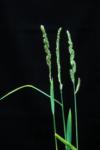Latin name
Echinochloa colona (L.) Link
Family
Poaceae
Common name(s)
Jungle rice, awnless barnyard grass
Synonym(s)
Echinochloa colonum (L.) Link, E. crus-galli subsp. colona (L.) Honda, Panicum colonum L. (basionym), P. cumingianum Steud., P. zonale Guss., Milium colonum (L.) Moench, Oplismenus colonus (L.) Kunth
Geographical distribution
Asia: China and Japan.
South and Southeast Asia: Bangladesh, Cambodia, India, Indonesia, Lao PDR, Malaysia, Myanmar, Nepal, Pakistan, Philippines, Sri Lanka, Thailand, and Vietnam.
Rest of the world: Australia, Bolivia, Botswana, Costa Rica, Ecuador, El Salvador, France, Fiji, Guatemala, Honduras, Iraq, Italy, Kenya, Mexico, Nicaragua, Paraguay, Peru, Portugal, Senegal, Spain, Tanzania, Uganda, United States, Venezuela, West Africa, and Zambia.
Morphology
A tufted annual grass, up to 60—cm—tall.
Stem: reddish purple or green, ascending to erect, without hairs.
Leaf: linear, 10—15—cm—long, basal portion often tinged with red; ligule absent.
Inflorescence: simple, ascending racemes, green to purple, about 5—15—cm— long; spikelets subsessile 1—3—mm—long.
Biology and ecology
Echinochloa colona flowers throughout the year and is propagated by seeds. Seeds have a short dormancy period.
Can be present in large numbers and responsive to nutrients. Prefers moist but unflooded conditions and is a problem mainly in upland and rainfed lowland rice fields rather than in flooded fields.
Agricultural importance
It closely "mimics" rice in the vegetative growth stage and can be a severe competitor of rice.
It is a host of diseases such as tungro and rice yellow dwarf. It can be used as a palatable fodder for milking animals and water buffalo.
Management
Cultural control: flooding; hand weeding or use of a hoe during early growth stages.
Chemical control: preemergence application of oxadiazon or pendimethalin or postemergence application of cyhalofop, butachlor, and fenoxaprop can be effective.
Selected references
Galinato I, Moody K, Piggin. CM. 1999. Upland rice weeds of South and Southeast Asia. Manila (Philippines): International Rice Research Institute. 156 p.Halfliger E, Schloz H. 1980. Grass weeds 1. Basle (Switzerland): Ciba-Geigy Ltd. 142 p.Holm L, Pancho JV, Herberger JP, Plucknett DL. 1979. A geographical atlas of world weeds. New York (USA): John Wiley & Sons, Inc. 391 p.Mew TW, Fabellar NG, Elazegui FA. 1980. Ecology of the rice sheath blight pathogen: parasitic survival. Int. Rice Res. Newsl. 5:16.Michael PW. 1978. Notes on Echinochloa in the Philippines. Philipp. J. Weed Sci. 5:16-18.Moody K. 1989. Weeds reported in rice in South and Southeast Asia. Manila (Philippines): International Rice Reseach Institute. 442 p.Moody K, Munroe CE, Lubigan RT, Paller Jr. EC. 1984. Major weeds of the Philippines. College, Laguna (Philippines): University of the Philippines at Los Baños. 328 p.Nirmal DJ, Jeyarajah R. 1992. Role of weeds as symptomless carriers to rice tungro virus. Madras Agric. J. 79:663-664.Paller Jr. EC, Valente FV, San Gabriel R. 1980. Field evaluation of different weed control approaches in transplanted tomatoes. In: Weed Science Report 1978-1979. College, Laguna (Philippines): Department of Agronomy, University of the Philippines Los Baños. p 76-79.Pancho JV, Obien Sr. 1995. Manual of ricefield weeds in the Philippines. Muñoz, Nueva Ecija (Philippines): Philippine Rice Research Institute. 543 p.
Contributors
JLA Catindig, RT Lubigan, and DE Johnson
